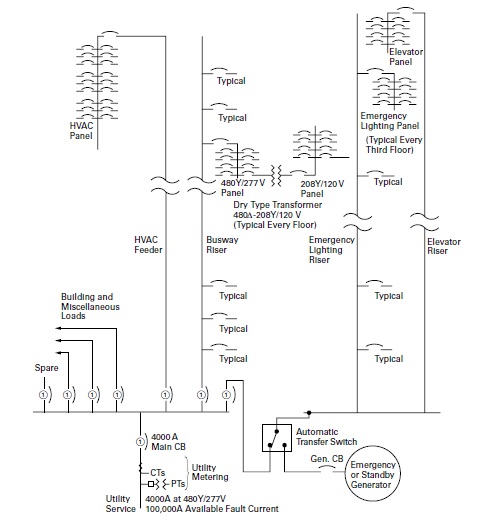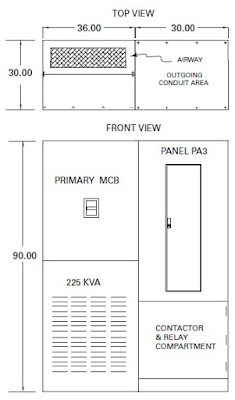In many cases, power is supplied
by the utility to a building at the utilization voltage. In these cases, the distribution
of power within the building is achieved through the use of a simple radial distribution
system.
Simple Radial System
In a conventional low-voltage
radial system, the utility owns the pole-mounted or pad-mounted transformers that
step their distribution voltage down from medium voltage to the utilization
voltage, typically 480/277 Vac or 208/120 Vac. In these cases, the service
equipment is generally a low-voltage main distribution switchgear or
switchboard. Specific requirements for service entrance equipment may be found
in NEC Article 230, Services.
Low-voltage feeder circuits are run from the
switchboard or switchgear assemblies to panelboards that are located closer to
their respective loads as shown in Figure 1.1-24. Each feeder is connected to
the switchgear or switchboard bus through a circuit breaker or other
overcurrent protective device. A relatively small number of circuits are used
to distribute power to the loads. Because the entire load is served from a
single source, full advantage can be taken of the diversity among the loads.
This makes it possible for the utility to minimize the installed transformer capacity.
However, if capacity requirements grow, the voltage regulation and efficiency
of this system may be poor because of the low-voltage feeders and single
source. Typically, the cost of the low-voltage feeder circuits and their
associated circuit breakers are high when the feeders are long and the peak
demand is above 1000 kVA.
Where a utility’s distribution system is fed by
overhead cables, the likelihood of an outage due to a storm, such as a
hurricane or blizzard, increases dramatically. Wind or ice formation can cause
tree branches to fall on these suspended cables, causing an unplanned power
outage. The failure of pole-mounted utility transformers canresult in an outage
lasting a day or more.
Additionally, a fault on the Service Switchgear or
Switchboards low-voltage bus will cause the main
overcurrent protective device to operate, interrupting service to all loads.
Service cannot be restored until the necessary repairs have been made. A fault
on a low-voltage feeder circuit will interrupt service to all the loads
supplied by that feeder.
An engineer needs to plan ahead for these contingencies
by incorporating backup power plans during the initial design of the power
system. Resiliency from storms, floods and other natural disasters can be
accomplished with the addition of permanently installed standby generation, or
by including a provision in the incoming Service equipment for the connection
of a portable roll-up temporary generator.
Note: See Generator and Generator
Systems in the Typical Power Systems
Components section of this Design Guide for further details.
 |
Figure 1.1-24. Low-Voltage Radial System
Figure 1.1-25 shows a typical incoming service switchboard
with the addition of a key interlocked generator breaker. In this design, the
breaker pair shares a single key that can only be used to close one breaker at
a time. This arrangement ensures against paralleling with the utility but
requires manual intervention in the event of an outage.
In a typical standby
generation arrangement, automatic transfer switches are used to feed either
Normal utility power or an alternate generator source of backup power to the
critical loads. The transfer switches sense the loss of power from the Normal source
and send a run command to the generator to start.
Once the generator is running, the transfer
switches sense that voltage is available and automatically open the Normal
contactor and close the Generator contactor. When the Normal source returns,
the transfer switch opens the Generator contactor and closes the Normal source
contactor.
The location and type of the transfer switches depends on the
Utility and the overall design intent. Transfer switches can be Service
Entrance Rated and used as the main Service Disconnect feeding all the loads
downstream. See Figure 1.1-26.
Transfer switches can be
also be incorporated into the service switchboard as an integral part of the
assembly.
Alternately, they can be located downstream of the incoming service
and applied only to the individual loads they are feeding. This approach of
isolating only those critical loads that must function during a power outage
can reduce the generator kVA necessary. This can reduce space and cost
requirements.
It is important to consider the grounding of the generator
neutral when using automatic transfer switches in power system design. If the generator
neutral is grounded at the generator, a separately derived system is created.
This requires the use of four-pole transfer switches for a three-phase system.
If
the three-phase generator neutral is brought back through the transfer switches
and grounded at the service entrance, a three-pole transfer switch with solid neutral
should be provided.
 |
Figure 1.1-25. Typical Incoming Service Switchboard
|
 |
Figure 1.1-26. Main Service Disconnect Feeding Downstream
|
In
cases where the utility service voltage is at some voltage higher than the
utilization voltage within the building, the system design engineer has a
choice of a number of types of systems that may be used. This discussion covers
several major types of distribution systems and practical modifications of
them.
1.
Simple medium-voltage radial
2.
Loop-primary system radial secondary system
3.
Primary selective system secondary radial system
4.
Two-source primary— secondary selective system
5.
Sparing transformer system
6.
Simple spot network
7.
Medium-voltage distribution system design
In
those cases where the customer receives his supply from the primary system and
owns the primary switch and transformer along with the secondary low-voltage
switchboard or switchgear, the equipment may take the form of a separate
primary switch, separate transformer, and separate low-voltage switchgear or
switchboard. This equipment may be combined in the form of an outdoor
pad-mounted transformer with internal primary fused switch and secondary main breaker
feeding an indoor switchboard.
Another alternative would be asecondary unit substation
where the primary fused switch, transformer and secondary switchgear or
switchboard are designed and installed as a closecoupled single assembly.
A
modern and improved form of the conventional simple medium voltage radial
system distributes power at a primary voltage. The voltage is stepped down to
utilization level in the several load areas within the building typically through
secondary unit substation transformers. The transformers are usually connected
to their associated load bus through a circuit breaker, as shown in Figure 1.1-28.
Each secondary unit substation is an assembled unit consisting
of a threephase, liquid-filled or air cooled transformer, an integrally
connected primary fused switch, and low-voltage switchgear or switchboard with
circuit breakers or fused switches. Circuits are run to the loads from these
low-voltage protective devices.
Because each transformer is located within a
specific load area, it must have sufficient capacity to carry the peak load of
that area. Consequently, if any diversity exists among the load area, this
modified pimary radial system requires more transformer capacity than the basic
form of the simple radial system.
However, because power is distributed to the
load areas at a primary voltage, losses are reduced, voltage regulation is improved,
feeder circuit costs are reduced substantially, and large low-voltage feeder
circuit breakers are eliminated. In many cases the interrupting duty imposed on
the load circuit breakers is reduced.
This modern form of the simple radial system
will usually be lower in initial investment than most other types of primary
distribution systems for buildings in which the peak load is above 1000 kVA. A
fault on a primary feeder circuit or in one transformer will cause an outage to
only those secondary loads served by that feeder or transformer. In the case of
a primary main bus fault or a utility service outage, service is interrupted to
all loads until the trouble is eliminated.
 |
Figure 1.1-27. Simple Radial System
|
 |
Figure 1.1-28. Primary and Secondary Simple Radial System
|
Reducing
the number of transformers per primary feeder by adding more primary feeder
circuits will improve the flexibility and service continuity of this system; the
ultimate being one secondary unit substation per primary feeder circuit. This of
course increases the investment in the system but minimizes the extent of an outage
resulting from a transformer or primary feeder fault.
Primary connections from
one secondary unit substation to the next secondary unit substation can be made
with “double” lugs on the unit substation primary switch as shown, or with load
break or non-load break separable connectors made in manholes or other locations.
See Eaton’s Cooper PowerE
series Molded Rubber Medium Voltage
Connectors on Eaton’s website for more details.
Depending on the load kVA
connected to each primary circuit and if no ground fault protection is desired
for either the primary feeder conductors and transformers connected to that
feeder or the main bus, the primary main and/or feeder breakers may be changed
to primary fused switches. This will significantly reduce the first cost, but
also decrease the level of conductor and equipment protection. Thus, should a
fault or overload condition occur, downtime increases significantly and higher
costs associated with increased damage levels and the need for fuse replacement
is typically encountered. In addition, if only one primary fuse on a circuit
opens, the secondary loads are then single phased, causing damage to
low-voltage motors.
Another approach to reducing costs is to eliminate the
primary feeder breakers completely, and use a single primary main breaker or
fused switch for protection of a single primary feeder circuit with all secondary
unit substations supplied from this circuit. Although this system results in
less initial equipment cost, system reliability is reduced drastically because
a single fault in any part of the primary conductor would cause an outage to
all loads within the facility.














